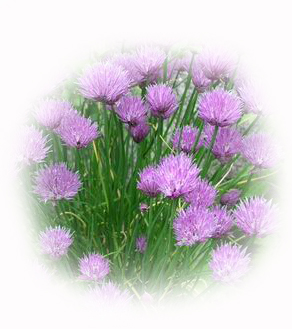Chives
|
|
| Allium schoenoprasum
Liliaceae
Legend and Lore Chives were recorded 4,000 years ago in China. Marco Polo also appreciated this herb and is native to Asia, Europe and America. In Latin "caepulla" means little onion. During the Middle Ages, chives were called "rush-leek" Schoenoprasum is derived from the Greek "schoinos" which means rush and "prason" leeks. Chives were not used as a culinary herb but as a medicinal one: antidote to poison. |
|
|
In the Garden
Leaves are cylindrical; taste is delicate and is the favored choice for the summer garden. Perennial that does not escape its' border, this is a well behaved plant. Plant in soil or pot it up in a sunny to a lightly shaded location. Divide plants every 3⁄4 years in the spring or sow seeds outdoors. Prefers rich, moist and well drained soil, water in dry spells and add compost yearly. To harvest cut leaves to 2" for re-growth, this can be done 2-3 times in the season. Pick flowers as they open. Leaves with flowers are bitter. Refrigerate leaves in a sealed plastic bag for one week, or freeze in ice cube trays, chives do not dry well. Blossoms can be used in most recipes calling for onions. In the garden chives is a good companion to carrots, tomatoes and vines. Protects roses from Black Spot, aphids, also enhances their scent and protects Malus (apples and crabapples) from scab and mildew. In the Kitchen |
|



